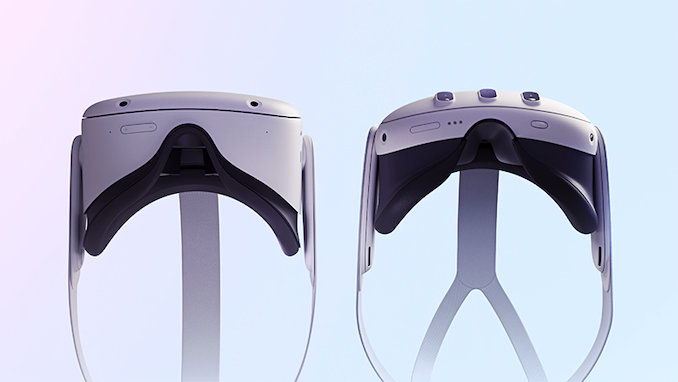
Meta Reveals Quest 3 VR Headset: Higher Resolutions and Next-Gen Snapdragon SoC
2023-06-02Meta on Thursday announced the Quest 3, its next generation all-in-one untethered VR/MR headset. The updated headset is based around a newer Qualcomm SoC for VR/MR applications, offering increased performance, a higher resolution display, improved controllers, an all-new 6-degree-of-freedom (6DoF) positional tracking system, and backwards compatibility with existing software developed for existing the Quest headset.
Meta’s Quest 3 comes with the company’s ‘highest resolution display yet’ coupled with slimmed down optics assembly to make the device thinner. Meta is not disclosing the display resolution or refresh rate just yet, but it is reasonable to expect that it exceeds per eye resolution of 1832×1920 resolution and 72 – 120 Hz refresh rate range featured on the Quest 2. Meta says that the Quest 3 has a 40% slimmer optics profile, enhancing the overall comfort of the device. However, it is necessary to note that comfort can be highly subjective and depends on individual ergonomic preferences.
To ensure decent performance at a higher resolution, Meta says the Quest 3 uses the ‘a next-generation’ Snapdragon system-on-chip that ‘delivers more than twice the graphical performance’ compared to Quest 2 (which uses the Snapdragon XR2) without defining the exact SoC. The only other VR SoC in Qualcomm’s lineup right now is the Snapdragon XR2+ Gen1 – used in the Quest Pro – but given Meta’s intentional imprecision here, it’s more likely it’s an even newer SoC, or possibly even something custom.
In addition to increasing display resolution and enhancing performance, Meta says they’ve also greatly improved sensor and tracking systems of the Quest 3. The headset has three pill-shaped sensors on the front panel: the left and right sensors are dual 4MP outward-facing RGB cameras capturing stereoscopic visuals, whereas the middle sensor is the depth sensor. Tracking cameras are one corners of the device and they also support hand tracking right out of box.
Meta says that its new Meta Reality technology enabled by the two RGB cameras and the depth sensor provide considerably more immersive mixed reality experience compared to that on Quest 3 and even on Quest Pro.
“Ultimately, our vision is to enable you to move through all realities in a way that’s intuitive and delightful,” said Mark Rabkin, VP of VR. “Going beyond the rigid classifications of ‘virtual reality’ and ‘mixed reality’ to deliver truly next-gen experiences that let you effortlessly blend the physical and virtual worlds. Meta Reality gives you both the deep, immersive magic of VR and the freedom and delight of making your physical world more fun and useful with MR. Weare excited to see what developers and creators can build on the Quest Platform when the possibilities are limitless.”
Last but not least, Meta re-engineered its Touch Plus controllers for the Quest 3 headset. The new controllers eliminate outside tracking rings and feature improved ergonomics. Furthermore, they add TruTouch haptics to enhance tactile interaction. Meanwhile, those who want to have an even better experience can buy Meta Quest Touch Pro Controllers which offer full self-tracking.
Meta says that it will reveal more details about its Quest 3 on September 27, raises the obvious question of whether the company announced the headset days before Apple is expected to unveil its own VR/MR headset to steal some thunder from that introduction. As for availability, the company plans to start selling its Quest 3 late this year for $499 for a 128GB version. Those who want to have more internal storage can opt for a more expensive model.


